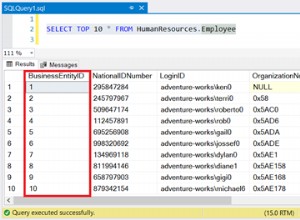Una riga è rappresentata da un tipo composto, come
CREATE TYPE mytype AS (
id integer,
name text,
fromdate timestamp with time zone
);
Puoi usare un tipo come argomento di funzione.
Per ogni tabella PostgreSQL esiste automaticamente un tipo con lo stesso nome e le stesse colonne:
CREATE TABLE mytable (
id integer PRIMARY KEY,
name text,
fromdate timestamp with time zone NOT NULL
);
Quindi puoi creare una funzione che accetta un array di questo tipo come argomento:
CREATE OR REPLACE FUNCTION myfunc(arg mytable[]) RETURNS void
LANGUAGE plpgsql IMMUTABLE STRICT AS
$$DECLARE
t mytable;
BEGIN
FOREACH t IN ARRAY arg LOOP
RAISE NOTICE 'id = %', t.id;
END LOOP;
END;$$;
Puoi chiamarlo in questo modo (supponendo che ci siano due righe in mytable ):
SELECT myfunc(array_agg(mytable)) FROM mytable;
NOTICE: id = 1
NOTICE: id = 2
┌────────┐
│ myfunc │
├────────┤
│ │
└────────┘
(1 row)
In alternativa, puoi creare una funzione che accetta un cursore come argomento:
CREATE OR REPLACE FUNCTION myfunc(arg refcursor) RETURNS void
LANGUAGE plpgsql IMMUTABLE STRICT AS
$$DECLARE
t mytable;
BEGIN
LOOP
FETCH NEXT FROM arg INTO t;
EXIT WHEN NOT FOUND;
RAISE NOTICE 'id = %', t.id;
END LOOP;
END;$$;
Questo può essere chiamato in una transazione come segue:
BEGIN;
DECLARE c CURSOR FOR SELECT * FROM mytable;
SELECT myfunc('c');
NOTICE: id = 1
NOTICE: id = 2
┌────────┐
│ myfunc │
├────────┤
│ │
└────────┘
(1 row)
COMMIT;




